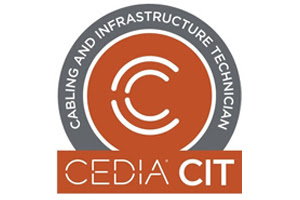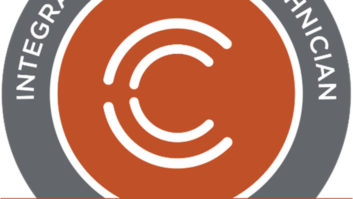From its earliest days, CEDIA has worked to support the professional development and recognition of integrators. As the industry has grown and matured, so has the need to provide a clearer definition of what work our technicians do and what it means to be considered a professional. Certification sets that bar in a meaningful and fair way that ultimately builds trust between the professional and the stakeholders they serve.

CEDIA is committed to supporting individuals who can showcase their own expertise and to raising the credibility of the collective industry as we evolve. One of the ways to do this is for our own certification programs to go through the rigorous process of being accredited to an international standard by a third-party entity. After two years of development, evaluation, and countless volunteer hours, CEDIA’s new Cabling & Infrastructure Technician (CIT) certification was recently awarded this distinction, which is a milestone for how far our industry has come.
Who Does the Accrediting?
To fully understand the gravity of accreditation, there are some key terms that are helpful to understand.
The International Organization for Standardization (ISO) is a globally recognized organization that specializes in developing international standards, as well as publishing them. They ensure the quality of standards from all types of industries all over the world, including numerous varieties of technology.
The International Electrotechnical Commission (IEC) oversees the preparation and publication of standards for electrical, electronic, and related technologies on an international level. They have a joint committee called the JTC that works with ISO to build standards in information technology.
The ANSI National Accreditation Board (ANAB) is a national body that “oversees standards and conformity assessment activities in the United States.” Their goal is simple — to make companies more competitive by ensuring high integrity standards on a voluntary level. They do this through evaluating certification programs, such as CEDIA’s Cabling and Infrastructure Technician, to make sure the process for awarding certifications is fair, valid, and reliable. ANSI is the United States’ “member body” to ISO and IEC.
Essentially, the ISO and IEC develop standards, often in collaboration, and ANAB verifies that organizations have met and continue to meet those standards. These esteemed bodies are globally recognized across industries for their work with standards and documentation. The process of accreditation is rigorous to ensure the quality is the same across the board rather than location-dependent.
Accreditation and CIT
The CIT exam provides a foundation for technicians who perform basic infrastructure wiring for low-voltage technology systems in a residential or commercial setting. For this reason, the exam applies to other low-voltage trades, such as HVAC, too. CEDIA’s volunteers and staff built the exam to be inclusive of trades other than custom integration because we recognize that many firms offer more than simple residential services. The CIT exam also covers basic equipment installation and is a pre-requisite for the Intermediate-level Integrated Systems Technician (IST) certification.
The CIT exam was approved for accreditation to ISO/IEC 17024:2012 in November 2021. This additional layer of formal recognition puts each person holding the CIT in a stronger position to demonstrate to employers and clients that they are qualified to do the work and can be trusted as a professional.
Accreditation and the Industry
Having an ISO/IEC 17024 accredited certification testifies to other trades, customers, and lawmakers that the custom integration industry is a clearly defined profession with meticulous, widely accepted criteria for competency.
With a community of certified professionals, there are more opportunities open for workforce development, alliance with other professional trade societies, and marketable value to clients. Trusted certifications also provide a shared reference point that can facilitate better connections between educational institutions, job seekers, and employers.
Looking Forward
CEDIA’s goal with the CIT exam is to set the baseline standard for what skills are necessary for any technician on a jobsite. It outlines the foundational knowledge needed and is meant to be a starting place for individuals who want to grow their career in home technology.
The next step forward on this path is the Integrated Systems Technician (IST) certification. The IST certification is undergoing the accreditation process during 2022 and will certify technicians who possess the broad range of skills necessary to independently complete tasks during the pre-wire (First Fix) and trim-out (Second Fix) phases of a project.
Having globally recognized certification opportunities brings buildable, transferrable skills to the table that differentiate the home technology industry. It shows dedication and professionalism on the part of those who get certified and reaffirms that we are a highly specialized and trustworthy industry.
If you want to create a benchmarking program for your team, or learn more about getting certified, visit cedia.net/certification. There are plenty of resources to assist you on your journey.
David Whitney is senior director of certification at CEDIA.







